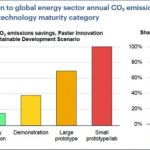Huangluolun Zhou, Elena Dahlem and Alex Schmitt at Energy Brainpool present their updated “EU Energy Outlook 2060”, modelling how the European energy system will undergo major changes in the coming decades while continuing to guarantee a secure supply and meet its climate targets. What do these developments mean for power prices, revenue potential and risks for solar PV and wind? The two main scenarios are “Central” and “GoHydrogen” for the EU 27 … [Read more…]
Europe must simultaneously replace Russia’s fossil exports and accelerate its clean energy deployment
The Ukraine crisis has had an immediate impact on Europe’s strategy for energy supply security. And this week’s sudden halting of gas supplies by Russia to Poland and Bulgaria only emphasises the urgency. Dolf Gielen, Ricardo Gorini, Luis Janeiro and Seán Collins at IRENA look at the best options, basing their findings on their latest “World Energy Transitions Outlook”, published in March, that lays out a routemap for the next eight years for … [Read more…]
U.S. EIA Annual Energy Outlook 2022 reveals no reduction in emissions to 2050
The U.S. Department of Energy’s Energy Information Administration (EIA) has released its influential 2022 “Annual Energy Outlook” (AEO2022) which projects the electricity mix over the next 30 years. (The modelling takes policies and global conditions as they were in November 2021, so the current Russia-Ukraine crisis is not accounted for, nor any future unforeseeable shocks, and assumes no new policies to 2050). Sandra Sattler at the Union of … [Read more…]
All estimates of the ‘cost’ of climate action should include the savings and benefits
Too many climate mitigation scenarios calculate the cost of that transition without measuring the savings and benefits, explain Alexandre Köberle and Joeri Rogelj at Imperial College London, Toon Vandyck at the EC’s Joint Research Centre, and Celine Guivarch at the Centre International de Recherche sur l’Environnement et le Developpement, writing for Carbon Brief. This leads to a pessimistic view of the challenges ahead, and public aversion to … [Read more…]
Lifting 3.6bn people out of poverty would raise global emissions by 18%
One criticism of the energy transition is that efforts made by the rich world will be negated by the rise in wealth and consumption in the developing world. A new study puts figures on that expected increase in emissions. Eradicating all “extreme poverty” – by raising hundreds of millions above the US$1.90 per day threshold – would drive up global carbon emissions by less than 1%. Lifting 3.6 billion people over the poverty line of US$5.50 per … [Read more…]
Corporations, Cities, Financial Institutions: can private collective action plug the global emissions gap?
Non-state actors – corporations, cities, and financial institutions – are making their own impact on emissions reductions. We don’t just have to rely on governments, explain James Newcomb, Jun Ukita Shepard and Laurens Speelman at RMI. Case studies of harnessing private collective action already exist, and they are significant. Take Power Purchase Agreements (PPAs). In the U.S., corporates ramped up annual renewables procurements from 0.1 GW to … [Read more…]
IEA WEO 2021 message to COP26: 40% of clean energy goals will cut costs
The IEA’s latest World Energy Outlook was published on Wednesday. This year’s WEO-2021 is released earlier than usual to inform COP26 and, for the first time, is available for free to ensure the widest possible audience. Simon Evans at Carbon Brief offers his summary of the 386-page report, quoting relevant numbers and charts. He first points to the new scenario, Net-Zero Emissions by 2050 (NZE), as the IEA’s recognition that this is what … [Read more…]
18 energy transition scenarios to watch: where they agree and disagree
A wide range of regions, nations and respected organisations have created net-zero strategies and pathways, but on what do they agree and disagree? Dolf Gielen, Asami Miketa, Ricardo Gorini and Pablo Carvajal at IRENA have done a meta-analysis of 18 recent energy transition scenarios to find out. There is consensus over the main strategies: renewable power generation, and the direct and indirect electrification of end-use sectors – these account … [Read more…]
The IEA explains its new “Net-Zero Emissions by 2050” roadmap
Today the IEA publishes its new special report, “Net Zero by 2050: a Roadmap for the Global Energy Sector”, its deepest dive so far into what’s needed for a successful global transition. It analyses the options as well as the socio-economic, behavioural and environmental impacts they will have globally. Here, Laura Cozzi (Chief Energy Modeller) and Timur Gül (Head of the Energy Technology Policy Division) at the IEA summarise the key principles … [Read more…]
The standard models overestimate the cost of the low carbon transition
Why have forecasts for new low-carbon energy consistently underestimated their cost reductions? The IEA has, famously, repeatedly had to raise its estimates for solar’s contribution every year since 2009, and now describes it as the “cheapest electricity in history”. Writing for Carbon Brief, Alexandra Poncia at Arup and Paul Drummond and Michael Grubb at University College London explain that standard models focus on “technology-push” policies, … [Read more…]
Outlook USA: even with battery costs, Wind and Solar can undercut Coal and Gas by 2023-24
IEEFA has published its U.S. Power Sector Outlook 2021. Its authors, Dennis Wamsted, Seth Feaster and David Schlissel summarise and explain the projections. They say that coal and gas are set to become the biggest losers as renewable generation climbs quickly. The future for wind and solar – coupled with storage to address intermittency – is looking very good. They present estimates from NextEra (the largest renewable energy developer in the … [Read more…]
China: decoupling GDP growth from rising emissions
To set up this week’s important online event (Tuesday 13th & Wednesday 14th April) “China: Carbon Neutral by 2060 -EFFICIENCY FIRST” we have an overview of China’s energy transition. Everyone agrees its performance is critical for the world to achieve the global goal of limiting warming to 1.5C by 2050. China made significant progress in 2020 with policy frameworks, renewable capacity additions and EVs, but it also added 38 GW of new … [Read more…]
New net-zero pledges from China, US, EU and others can meet our climate goals, says UNEP. But…
Existing national commitments imply that today’s emissions will simply plateau, remaining only slightly below 2019 levels by 2030. However, according to the latest UN Environment Programme (UNEP) emissions gap report, the new commitments from China, the EU, Japan, South Korea, the UK, Joe Biden’s US and others are “broadly consistent” with the Paris Agreement’s 1.5C goal for 2050. But commitments aren’t policy, warns UNEP, and only real change … [Read more…]
The IEA’s World Energy Outlook 2020 at a glance
This month the IEA published its annual flagship World Energy Outlook (WEO). Simon Göss at Energy Brainpool picks out his highlights. This year’s WEO has four scenarios, two of them new: an updated “Stated Policies Scenario” (STEPS: what governments have promised), the new “Delayed Recovery Scenario” (DRS: due to Covid), an updated “Sustainable Development Scenario” (SDS: what’s needed to meet the Paris targets), and the new “Net Zero Emissions … [Read more…]
Are 1.5°C scenarios supplanting “Business As Usual” as the new benchmark?
The world energy outlooks published annually by the IEA, BP and DNV GL look very different this year. 1.5°C scenarios are being taken much more seriously. Could it be because of the trauma of Covid-19, or the extraordinary – though still insufficient – success of renewables coupled with the rising ambition of climate-aware governments and their policies? Either way, they are helping to shift the debate away from the mainstream “business as usual” … [Read more…]
- 1
- 2
- 3
- …
- 16
- Next Page »















